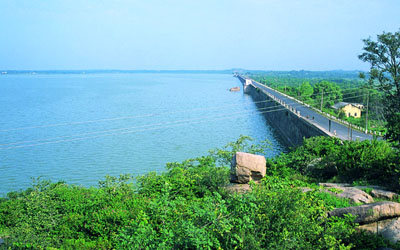Rama Krishna Sangem
A GO (Government Order) No 111 (dated March 8, 1996) has been withdrawn. In its place came another GO 69 on April 21, Thursday. Chief Minister K Chandrasekhar Rao (KCR) headed TRS government in Telangana has made these changes to remove limits on the land pool available for the growth of Hyderabad city. This is also a popular demand of as many as 84 villages on the western and south-western part of the metro city for several years.
The GO 111 was brought 26 years ago, to safeguard two historical lakes – Himayat Sagar and Osman Sagar – on the western side of Hyderabad, that supply drinking water to the city for several decades. These lakes were built by the Nizams. After rapid commercialization of construction activity around the city began in early 1990s, the AP High Court imposed restrictions polluting construction activity on a radius of 10 km from the full tank level of these reservoirs in 1994.
Then came this GO 111, which imposed many limits on construction of high rise structures, industries etc. As a result, land value in 84 villages has been hit, though the same has gone up elsewhere around the city. If the land value of western parts of the city is around Rs 1 lakh per sq yard, the same is not even Rs 10,000 per sq yard in the villages that come under GO 111. Realtors usually refer them as “111 GO lands”. Around 1.32 lakh acres of land is in this zone.
Successive governments were tempted to remove the GO 111, but shied away, as they were afraid of being called “anti-Green”. This debate over GO 111 over the years became – Growth Vs Green”. Ironically, many prominent politicians, businessmen and major realtors, have purchased lands and built luxury farm houses here. They paid throwaway prices to farmers who sold their lands.
Demands for removal of GO 111
Ever since Telangana was formed eight years ago, there was a talk that this GO would go. CM KCR who received many representations from different people, mostly the villagers hit by this GO, did an elaborate study and came to the view that the GO 111 was not needed now. Even in the GO 69, which was removed GO 111, the background conditions that were there 26 years ago, are not there now.
In early 1990s, Hyderabad city’s drinking water demand was around 225 MGD (million gallons per day). Of this, 145 MGD (or less) came from these lakes. Then, the area of Hyderabad city was 185 sq km, with a population of around 60 lakh. Now, the city has expanded, in stages, to 825 sq km with a population of over 1.10 crore. The drinking water needs are more than 1,200 MGD.
According to details furnished by HMWS&SB (Hyderabad Metro Water Works & Sewerage Board), that look after the drinking water supply of Hyderabad city, its total installed capacity is now 602 MGD while another 344 MGD is under execution, a total 646 MGD. If the two lakes accounted for 27.59 per cent of the drinking water needs 26 years ago, when the GO was issued, now it is just 1.25 per cent. Very insignificant.
Tipping Point for GO 111
So, the government came to the conclusion that the tipping point is in favour of removing the GO 111. You just can’t stop growth in 1.32 lakh acres of 84 villages for the sake of two lakes. The removal of restrictions will also help removal of dubious transactions – rich people buying lands from poor farmers at cheaper rates. Building semi-permanent farm houses, instead of pucca skyscrapers.
Of course, environmentalists and green activists will not agree with this argument. They went to the High Court and Supreme Courts and National Green Tribunal (NGT) in the past and even now there are some cases. They will definitely move these courts and NGT against GO 69 too. They say, unbridled commercial activity in the purview of GO 111 will certainly kill these two lakes within a few years. An environmental disaster, if that happens.
The panel must prove that it is not “Growth Vs Green”, but “Growth with Green”.
Government careful
KCR’s government doesn’t want that blame. That is why, the GO 69 has been well drafted, with measures to see to it that the two lakes are preserved. An officials committee headed by Chief Secretary Somesh Kumar has been set up to deal with this tricky question – saving these two lakes, without the protection of GO 111. That’s a challenge to the panel members – all senior IAS officers. They need to do a balancing act.
Many environmentalists and real estate experts who spoke to Excel India are of the view that the government must deal with the situation responsibly. “Government doesn’t want to kill the two lakes, but also doesn’t want to kill the growth of the city,” said a senior official in MA&UD (municipal administration & urban development), summing up the mood in the government.
Hyderabad growing
What are the spin off affects of GO 69? Hyderabad city will further expand, consolidating its place in the country as a major business hub. Already, the city is fast spreading – up to and beyond Outer Ring Road. Every year, close to 10,000 acres of land is being added to the real estate purposes. Now, this addition of around 1 lakh acres (excluding an estimated 30,000 acres for green zones around the two lakes) will make Hyderabad larger & larger.
Prices of real estate will go up (in the limits of 84 villages), and down in other parts. But, in the next couple of years, they will stabilize, at an average Rs 60,000 – Rs 70,000 per sq yard, some experts say. Hyderabad will grow westward. Big corporate companies prefer bulk lands here, as other major metros – Mumbai, Delhi and Bangalore – have become too expensive.



Very good article. A comprehensive essay on 111 G.O. Very informative and analytical.